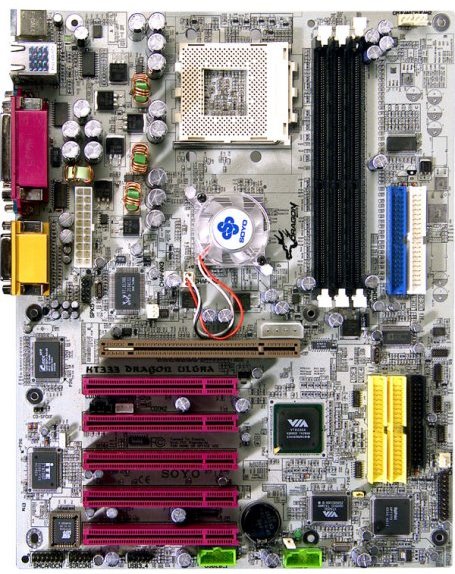|
Allow me to use the same SOYO provided picture while we discuss the layout and apologies again for my less than amazing pictures of the board.

As you can see it's a full 9-hole ATX mount which shouldn't be a problem for many but look out if your case is smaller than the norm. Let's start off at the top left as usual work and our way right and down.
Not much power regulation circuitry in the top left like we've seen on recent motherboards but that's not a bad thing provided the board is stable under high loads and the ATX connector position also affects the positioning of the components here, helping to spread them from the top left down the left flank to the connector itself.
Moving right we come across SOYO's regular rotated socket. I used to hate this when I ran water cooling but since it's back to air cooling, I don't mind so much. It's rotated 90 degrees clockwise from the usual orientation of socket A boards from other manufacturers but it passes the Swiftech test and my MCX462 fit without incident. Other large 80mm sinks should be fine.
Past the CPU socket area we see the 3 DIMM slots with suprisingly large and good quality (as much as you could call bits of white plastic quality) end clips. Nothing unusual so far and the north-south southbridge provided IDE ports are in a standard location.
Under the CPU socket area on the left we see the north-south ATX connector, not an ideal placement since in many cases it will mean dragging the cable across the CPU socket area, hindering good airflow. It's just about the only poor component placement on an otherwise standard motherboard. Under the CPU socket itself is the actively cooled northbridge with a good looking and surprisingly quiet fan sat atop a silver heatsink.
I've heard more than my fair share of noisy northbridge fans so it was nice to hear a quiet one.
The Realtek network controller is in the vicinity and the AGP slot is flanked by a 12V power socket which you feed with a molex connector just like your hard drive or optical devices. This requires yet another cable to be dragged across the board making it more akin to a power hungry Pentium 4 board than your usual Socket A AMD fodder. We can only presume it's for extra piece of mind when stressing the system, especially at high front side bus frequencies.
The board was certainly very stable when overclocked during testing.
Moving down from the AGP slot and everthing is placed normally with southbridge (uncooled), PCI slots and HPT372 chip all in the usual places. ATX case headers and the extra headers for USB and the Sigma Box are all underneath the last PCI slot along with the audio headers for CD-ROM audio.
All in all, a decent layout but this reviewer doesn't like the rotated socket, ATX connector placement and the need for the extra 12V source, although nothing is too bad and the extra power source seems to help stability. 8 out of 10 for the layout.
|